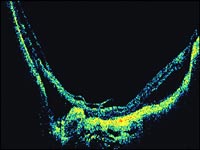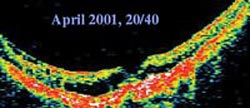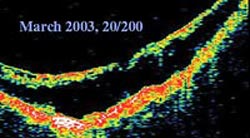OCT detects previously undetectable retinal tractions and macular damage
For these features, present in more than one-third of highly myopic patients, the term myopic traction maculopathy has been proposed.
 A OCT scan of myopic traction maculopathy. Two areas of outer retinoschisis (resembling shallow serous retinal detachments) are present over two zones of scleral weakness and bulging. An internal retinoschisis is visible on the left, and an epiretinal membrane, covers the foveal area. |
 |
 |
 Progressive worsening of MTM over three years. Visual acuity dropped from 20/40 to 20/400. Images: Panozzo G
|
Posterior retinal tractions and related macular changes, undetected by fundus examination but visible on optical coherence tomography, are present in a high number of extremely myopic eyes, and might be the cause of acute or progressive visual loss, according to a study.
“These tractions, which are induced by the epiretinal membrane (ERM) and/or by residual vitreoretinal adhesion, should be added to the well known causes of visual impairment in degenerative myopia. Many cases of visual loss in highly myopic eyes might be due to these rather than other and better-known causes. Routine examinations will not detect these changes, which might remain undiagnosed until it’s too late for effective treatment,” said Giacomo Panozzo, MD, whose findings were published in the October 2004 issue of Archives of Ophthalmology.
For the abnormal macular changes and visual impairment generated by these tractions, combined with the complex and distinctive anatomy of degenerative myopia, he proposed using the name myopic traction maculopathy (MTM).
A high incidence
Due to the anomalous, disorganized appearance of the choroid, retina and vitreoretinal interface of eyes with degenerative myopia, the early stages of MTM can easily be underestimated, Dr. Panozzo said.
“If nothing new is seen even after the most attentive evaluation with ultrasonography, biomicroscopy and angiography, the most obvious conclusion is that the visual loss is just part of the natural history of the disease, due to the stretching of the sclera and progressive thinning of the retina,” Dr. Panozzo said in an interview with Ocular Surgery News.
Between April 2001 and May 2002 Dr. Panozzo examined all highly myopic patients using OCT, for a total of 218 eyes with myopia ranging between –8 D and –26 D.
Some of the eyes were asymptomatic (vision had remained stable for at least 2 years) and others were symptomatic (increased metamorphopsia with visual loss equal or greater than 2 lines over the past 6 months).
Following complete ophthalmic evaluation, the patients were examined with the OCT optical coherence tomographer (Carl Zeiss Meditec), with a resolution of 10 µm and special scanning techniques. The analysis of OCT images focused on the presence of epiretinal traction and on changes in retinal structure.
“Retinal damage was present in 43 eyes (34.4%), and in 36 eyes (83.7%) it was associated with epiretinal traction, isolated or combined with staphyloma. Only 7 eyes (16.2%) had a posterior staphyloma without epiretinal traction,” Dr. Panozzo said.
He added that of these 43 patients only 14 were judged symptomatic. This demonstrates that most patients (and ophthalmologists) might be unaware of these retinal changes for a long time and delay the appropriate treatment, he said.
“In the meantime, the damage caused by retinal tractions progresses, while just a simple vitrectomy would stop this process,” he noted.
OCT should become routine
Dr. Panozzo said that the results of his study were beyond his expectations.
“We shouldn’t underestimate the fact that more than one third of high myopia patients, in the presence or absence of visual symptoms, present this form of traction-related retinal damage. I strongly suggest that OCT should become part of the routine examination of all high myopia patients. In quite a few cases I have performed a vitrectomy that would have been delayed otherwise,” he said.
“I have performed vitrectomy in 30 of these eyes, and only had two cases of retinal detachment. In all the other eyes the operation halted the progression of visual loss, and more than half of the eyes gained at least two visual acuity lines. Without the OCT findings, all these patients would have been sent home without any treatment prospect,” he pointed out.
For Your Information:
- Giacomo Panozzo, MD, can be reached at Vitreoretinal Service, Teclo srl, Via del Perlar 2, 37135 Verona, Italy; +39-045-502390; fax: +39-045-8205662; e-mail: g.panozzo@iol.it.
- Carl Zeiss Meditec, maker of the OCT, can be reached at 5160 Hacienda Dr., Dublin, CA 94658 U.S.A.; +1-925-557-4100; fax: +1-925-557-4101.
- Michela Cimberle is an OSN Correspondent based in Treviso, Italy.
